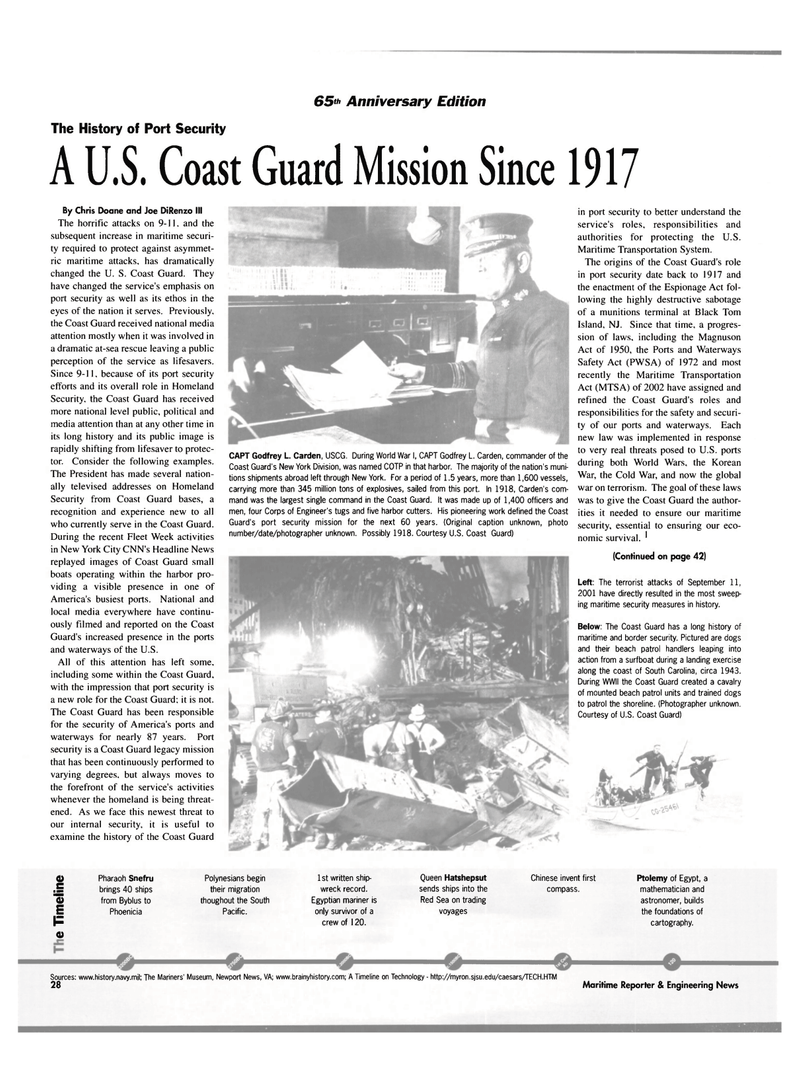
Page 28: of Maritime Reporter Magazine (August 2004)
65th Anniversary Edition
Read this page in Pdf, Flash or Html5 edition of August 2004 Maritime Reporter Magazine
65»' Anniversary Edition
The History of Port Security
A U.S. Coast Guard Mission Since 1917
By Chris Doane and Joe DiRenzo III
The horrific attacks on 9-11. and the subsequent increase in maritime securi- ty required to protect against asymmet- ric maritime attacks, has dramatically changed the U. S. Coast Guard. They have changed the service's emphasis on port security as well as its ethos in the eyes of the nation it serves. Previously, the Coast Guard received national media attention mostly when it was involved in a dramatic at-sea rescue leaving a public perception of the service as lifesavers.
Since 9-11, because of its port security efforts and its overall role in Homeland
Security, the Coast Guard has received more national level public, political and media attention than at any other time in its long history and its public image is rapidly shifting from lifesaver to protec- tor. Consider the following examples.
The President has made several nation- ally televised addresses on Homeland
Security from Coast Guard bases, a recognition and experience new to all who currently serve in the Coast Guard.
During the recent Fleet Week activities in New York City CNN's Headline News replayed images of Coast Guard small boats operating within the harbor pro- viding a visible presence in one of
America's busiest ports. National and local media everywhere have continu- ously filmed and reported on the Coast
Guard's increased presence in the ports and waterways of the U.S.
All of this attention has left some, including some within the Coast Guard, with the impression that port security is a new role for the Coast Guard; it is not.
The Coast Guard has been responsible for the security of America's ports and waterways for nearly 87 years. Port security is a Coast Guard legacy mission that has been continuously performed to varying degrees, but always moves to the forefront of the service's activities whenever the homeland is being threat- ened. As we face this newest threat to our internal security, it is useful to examine the history of the Coast Guard (Continued on page 42)
Left: The terrorist attacks of September 11, 2001 have directly resulted in the most sweep- ing maritime security measures in history. in port security to better understand the service's roles, responsibilities and authorities for protecting the U.S.
Maritime Transportation System.
The origins of the Coast Guard's role in port security date back to 1917 and the enactment of the Espionage Act fol- lowing the highly destructive sabotage of a munitions terminal at Black Tom
Island, NJ. Since that time, a progres- sion of laws, including the Magnuson
Act of 1950, the Ports and Waterways
Safety Act (PWSA) of 1972 and most recently the Maritime Transportation
Act (MTSA) of 2002 have assigned and refined the Coast Guard's roles and responsibilities for the safety and securi- ty of our ports and waterways. Each new law was implemented in response to very real threats posed to U.S. ports during both World Wars, the Korean
War, the Cold War, and now the global war on terrorism. The goal of these laws was to give the Coast Guard the author- ities it needed to ensure our maritime security, essential to ensuring our eco- nomic survival. '
Below: The Coast Guard has a long history of maritime and border security. Pictured are dogs and their beach patrol handlers leaping into action from a surfboat during a landing exercise along the coast of South Carolina, circa 1943.
During WWII the Coast Guard created a cavalry of mounted beach patrol units and trained dogs to patrol the shoreline. (Photographer unknown.
Courtesy of U.S. Coast Guard)
CAPT Godfrey L. Carden, USCG. During World War I, CAPT Godfrey L. Carden, commander of the
Coast Guard's New York Division, was named COTP in that harbor. The majority of the nation's muni- tions shipments abroad left through New York. For a period of 1.5 years, more than 1,600 vessels, carrying more than 345 million tons of explosives, sailed from this port. In 1918, Carden's com- mand was the largest single command in the Coast Guard. It was made up of 1,400 officers and men, four Corps of Engineer's tugs and five harbor cutters. His pioneering work defined the Coast
Guard's port security mission for the next 60 years. (Original caption unknown, photo number/date/photographer unknown. Possibly 1918. Courtesy U.S. Coast Guard) fl> e • ^m "3 E
F o
Pharaoh Snefru brings 40 ships from Byblus to
Phoenicia
Polynesians begin their migration thoughout the South
Pacific. 1st written ship- wreck record.
Egyptian mariner is only survivor of a crew of 120.
Queen Hatshepsut sends ships into the
Red Sea on trading voyages
Chinese invent first compass.
Ptolemy of Egypt, a mathematician and astronomer, builds the foundations of cartography.
Sources: www.history.navy.mil; The Mariners' Museum, Newport News, VA; www.brainyhistory.com; A Timeline on Technology - http://myron.sjsu.edu/caesars/TECH.HTM 28 30 Maritime Reporter & Engineering News

 27
27

 29
29
